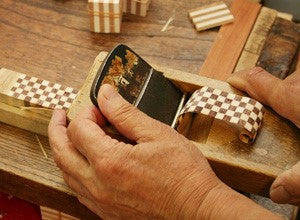Hakone Marquetry...
Nov 08 2016 0 Comments
The mountains in the Hakone area of Japan are known to be one of the areas with a wide variety of trees, along with Arashiyama in Kyoto and Daisen in Tottori. Hakone Yosegi Zaiku, or Hakone marquetry, is one of the traditional handicrafts in Hakone, generally called Hakone Zaiku. It is a very unique type of woodwork in Japan, and extremely stunning, which is developed receiving the benefits from the rich natural resources in Hakone. This craftwork creates a detailed geometric pattern or mosaic with pieces of different kinds of woods, making the most of the natural tinges of the material. It is often used for small boxes to keep jewelries, for example.
There are two kinds of Hakone Zaiku: Hiki-mono (lathe work) and Sashi-mono (cabinet work). Hiki-mono is a type of craftwork created by using a turning lathe, and it includes circular trays, bowls and circular dining tables. Since the Meiji period, this technique has also been used to make toys for children. The products of Sashi-mono are mainly boxes whose surfaces are decorated with wooden mosaic and inlaid work.
Click on the picture to watch the video.
This technique of Hakone Yosegi Zaiku, or Hakone marquetry, was invented in the late Edo period by Nihei Ishikawa (1790-1850) who lived in Hatajuku, Hakone-machi.
The materials used are Natural Wood, natural lacquer and glue. Pieces of different colours of wood are planed to the desired thickness. They are layered according to the pattern and glued together. The layered material is cut with a handsaw in order to produce a unit pattern, using the marquetry frame, which is unique to this technique.
The unit patterns are carefully planed and smoothed. To create a larger pattern, each of these completed unit patterns is glued on one side. The unit patterns are combined and bound together with a thread. These units glued together are cut with a handsaw in order to enlarge the pattern.
The patterns cut into many pieces are assembled and glued again. By repeating this process, the pattern becomes bigger and bigger. The resulting large piece of wood is called Tanegi.
Tanegi is planed away and a thin sheet of wood is produced. This sheet of wood is called Zuku.
Zuku is usually curled when it is planed off from the wood; therefore, it is ironed to flatten and it is now ready to be used for decorating a small box.
Cheers, Gaston
0 comments


Leave a Comment